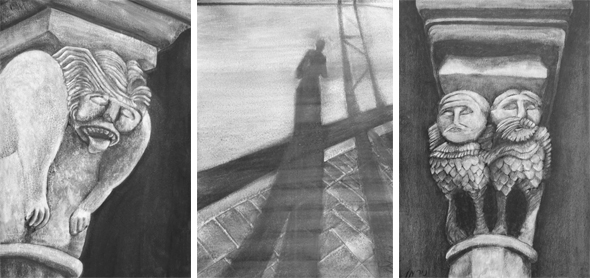רות נורמן — פני אבן
שישי, 19.10.12 | שעה 12:00

אודות התערוכה
קשת אבן מקושטת ומתפוררת בקיסריה שבתה את ליבה וסקרנותה של רות נורמן ומכאן ההשראה לסדרה “פני אבן”. חמושה במצלמת טלפון יצאה ללכוד באקראי את עברה המפואר של היפה בערים. בקיסריה הגשים הורדוס את חזונו לבנות עיר נמל תוססת ויפיפייה הבנויה כולה אבן גיר לבנה. במסעה בין החורבות, מצאה פסלים מעוטרים לבושים בבגדי אבן מדויקים שעל אף תמורות הזמן והחורבן שמרו על חינם. מאות צילומים צולמו בחיפזון ובספונטניות, מקרוב מאד ומרחוק מאד, בעדשתה המעוותת של טכנולוגיה נגישה. את האיזון, הדיוק והרגש שבין המושלם למתפורר, מצאה נורמן בפסל של הליוס- אל השמש- בפניו העגולות, הקורנות והשבורות.
בבואה להנציח את פני האבן שובות הלב, השתמשה בטיפקס על גבי נייר שחור. הטכניקה הזו לא חדשה לנורמן, אלא שכאן השימוש בחומר שמקורו באבן גיר התבקש מאליו על מנת לגשר ולקשר בין מעשה האמנות הקדום לבין זה העכשווי, בין התלת ממדיות של האבן לבין השטיחות של הציור.
בביקור מקרי באלבניה- שעל כל גבעה וצוק נבנו ערים קטנות שהן אוצר בלום של חורבות שלא טופלו מאות שנים- העשירה נורמן את רפרטואר האבנים שלה. במקדשים הרומאיים ובכנסיות האורתודוכסיות הביזנטיות, גם לעמודים התומכים פנים היברידיות של אדם וחיה. בפסלי האבן האפולונים מצאה נורמן מראה ייחודי המורכב מאלמנטים מפלצתיים מלאי הומור: האריה החושף את שיניו בהפחדה עומד על רגלי תרנגולת או גבר ואשה מחוברים עם שפם. בציירה את הדמויות האלה, חשה נורמן קרבה מרובה אל הפַּסָּל ואל תחושותיו כשבא לתאר גבורה, יצריות, מיניות, אכזריות ותמימות באירוניה.
הטכניקה של נורמן מתמודדת עם האירוניה הזו פעמיים. בראשונה כאשר האור והדימוי נוצרים בהיפוך, הרקע שחור והציור הבוקע ממנו בלבן. בשנייה, באופן השימוש בחומר. כיון שהטיפקס מתייבש במהירות, יש צורך לעבוד בזריזות וללא אפשרות לתיקונים. כדי להימנע מחיפזון יוצרת נורמן שלוליות חומר על גבי הנייר, הטרפנטין מתנדף ועל הנייר נוצרים ענני חומר מדולל שנורמן מוחקת כדי ליצור את הדימוי. המחיקה החושפת את פני האבן ועושה אור וסדר על גבי הנייר, היא כמו מעשה הפַּסָּל המבקע מתוך האבן את פני הדמויות.
הסדרה מגיעה לידי שיא כאשר מטילה נורמן את צלה על פני מרצפות עירוניות בצבעי שמן על גבי עץ מלא, כמענה מודרני, חצוף ואירוני ל”פני האבן” הקדומות.
נעילת התערוכה: 18.11.2012
Ruth Norman — Face of Stone
Thursday 19.10.12 | at 12:00
In her journey through the ruins she found ornamental statues dressed in meticulous stone gowns that preserved their charm through time and devastation. Hundreds of spontaneous, extreme close-ups and longshots were hurriedly taken through the distorting lens of accessible technology. Norman found the balance, precision and sentiment between the perfect and crumbling in a statue of Helios – the sun god – with his round, radiant broken face.
She used Tipp-Ex on black paper to immortalize the captivating stone face. Norman has used this technique before but here the use of a limestone derivative was a self-evident bridge between ancient and contemporary art, between the stone’s three dimensionality and the painting’s flatness.
A random visit to Albania, where small towns were built on every hill and cliff – a treasure of historically untended ruins enriched Norman’s stone repertoire. In the Roman temples and Orthodox Byzantine churches even buttresses have hybrid human-animal faces. Norman discovered a unique monstrous humoristic expression: a menacing lion baring his teeth standing on chicken feet; man and woman joined by a mustache. Drawing these figures brought Norman closer to the sculptor and his sentiments when ironically describing heroism, sensuality, sexuality, cruelty and innocence.
Norman’s technique confronts this irony twice. First, when light and image are reversely created: the dark background and the painting radiating from it in white. Next, in the handling of substance: Tipp-Ex dries rapidly dictating swift application with no possibility for repair. To avoid haste, Norman creates puddles of the material on paper, the turpentine evaporates and clouds of diluted material are created on the paper – requiring to be erased for the image to emerge. Erasure exposes the stone faces spreading light and order on the paper. She is like a stonemason shattering his subjects from the stone.
The series reaches a climax when Norman throws her shadow on urban tiles in oil paint applied on wood in a modern, mischievous and ironic response to ancient stone-faces.
Closing: 18.11.12
